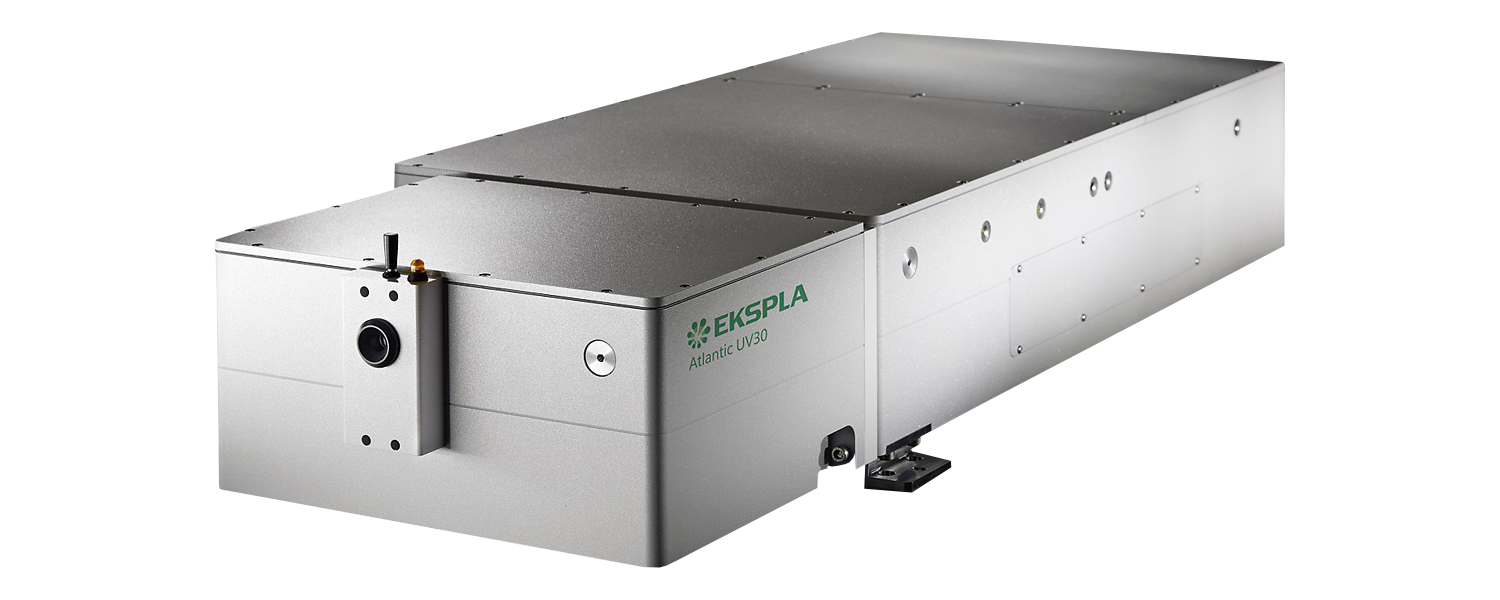Atlantic
High-power picosecond laser for industrial applications
The water-cooled picosecond lasers of the Atlantic series with high pulse energy and high power are designed for a wide range of material processing applications

Features
- Output power up to 80 W at 1064 nm, pulse energy up to 200 µJ
- Optional 532nm and 355nm
- Repetition rate up to 1 MHz
- Short pulse duration: 10 ps
- Beam quality: M² < 1.3
- Versatile laser control and synchronization options
- Intelligent triggering with polygon scanner and PSO
- Monolithic, hermetically sealed and robust design
- Low operating costs
Applications
- Drilling
- Cutting
- Structuring
- Ablation
- Dicing
- Micromachining
- Cutting LCD and OLED displays
- Laser-induced transfer (LIFT – Laser Induced Forward Transfer)
- Drilling and tracing of polycrystalline diamond (PCD)
- Cutting and drilling PET, PP, PTFE and silicone
Scientific publications
Laser-generated nanoparticles from Fe-based metallic glass in water and its amorphization control by pulsed laser processing
S. Liang, M. E. R. Reusmann, K. Loza, S. Zerebecki, L. Zhang, Z. Jia et al, Materials Today Chemistry 30, 101544 (2023). DOI: 10.1016/j.mtchem.2023.101544.
The laser synthesis and processing of colloids represents a group of scalable and “green” synthesis methods of crystalline metal oxides, that have recently made encouraging progresses in preparing amorphous as well as defect-rich nanoparticles. The relevant conditions and mechanisms that allow the design of amorphous metal oxides (AMOs) remain unknown. Consequently, in this work the synthesis of Fe-based partially amorphous oxide nanoparticles (NPs) by pulsed laser ablation in water was studied. Furthermore, both laser pulse duration and the number of laser pulse in pulsed laser fragmentation in liquid (LFL) allow a precise control of amorphization of AMOs in water. Hereby, a high-fluence nanosecond-LFL provides a significantly higher amorphization rate, whereas picosecond-LFL always presents minor fractions of crystalline α-Fe even with a higher specific energy input and laser intensity. Consequently, the laser fluence required for the repeated melting and quenching of NP appears to be the decisive parameter to control amorphization. During laser synthesis and processing of colloids, the amorphization of AMOs appears to be linked to the apparent size reduction effect, while a complete full amorphization of AMOs may be attributed to the stronger oxidation effects. This work will stimulate future studies using laser-generated AMO NPs for further functional purposes.
Glass dicing with elliptical Bessel beam
J. Dudutis, R. Stonys, G. Račiukaitis, and P. Gečys, Optics & Laser Technology 111, 331-337 (2019). DOI: 10.1016/j.optlastec.2018.10.007.
In this paper the possibility to optimize the glass dicing process by controlling the axicon-generated Bessel beam ellipticity is presented. Single-shot intra-volume modifications in soda-lime glass followed by dicing experiments of 1 mm-thick samples are performed. The Bessel beam ellipticity is essential for glass dicing process. Such beam generates intra-volume modifications with transverse crack propagation in dominant direction. Orientation of these modifications parallel to the dicing direction gives significant advantages in terms of processing speed, glass breaking force and cutting quality.
Processing of ultra-hard materials with picosecond pulses: From research work to industrial applications
V. Stankevič, A. Čermák, S. Mikalauskas, P. Kožmín, S. Indrišiūnas, and G. Račiukaitis, Journal of Laser Applications 30 (3), 032202 (2018). DOI: 10.2351/1.5040633.
The ultrashort laser processing of the cutting tools and cutting inserts from tungsten carbide, ceramic and metal composites (CERMET), and polycrystalline diamond materials was demonstrated, and the ablation rates of mentioned ultra-hard materials were evaluated for a laser wavelength of 1064 and 532 nm. The optimal processing throughput was estimated. Laser manufacturing was performed with the five-axis computer numerical control (CNC) machine and scanner for beam translation with the high speed and the ultrashort ∼12 ps pulse duration high repetition rate laser source. The systematic approach was implemented in an experimental variation of process parameters that play a significant role in processing quality. By varying the laser fluence, pulse overlap, and layers’ count, different material removal rates can be achieved from 300 nm/layer to ∼18 μm/layer. The submicrometer removal rate involves a high precision control of the structure depth. It was demonstrated that only by a minor change of the processing parameters, the surface roughness of the material could be minimized down to Ra<300 nm. Rough and smooth processing can be combined to optimize the structure processing throughput.
